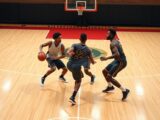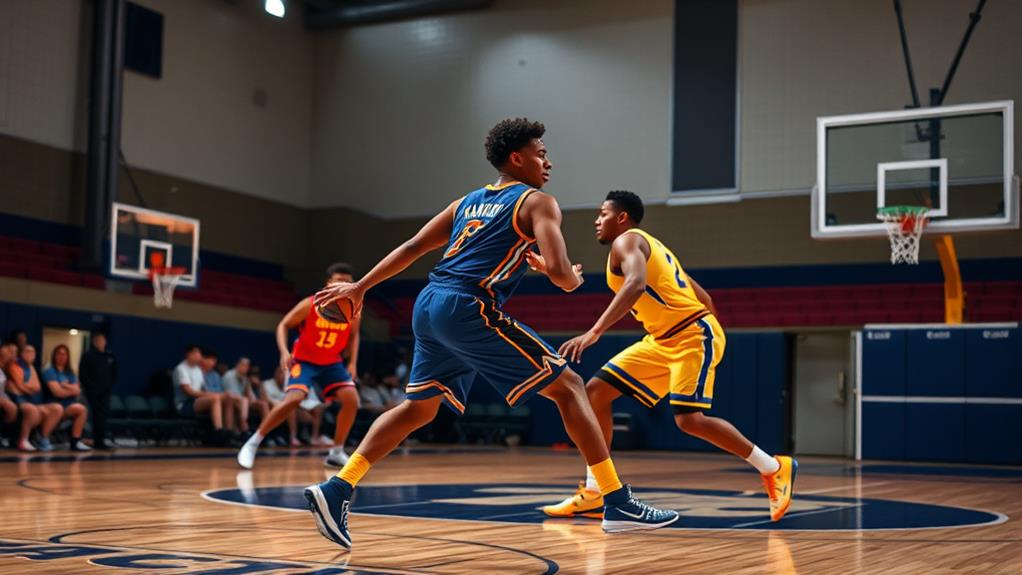
How to Run the Pick and Pop in Basketball
September 26, 2024To run the pick and pop effectively in basketball, start by having the screener set a solid screen for the ball handler. Once the screen is set, the screener should pop to the perimeter while the ball handler uses the screen to create separation. It's essential to communicate clearly and quickly assess the defense's reaction. As a ball handler, maintain a low stance and keep your head up to spot open teammates. By mastering these techniques and focusing on timing and decision-making, you'll enhance your offensive options and discover more about successful execution strategies.
Overview of Pick and Pop
The pick and pop is an essential offensive strategy in basketball that can create open shots and mismatches. In this play, a screener sets a screen for the ball handler, then pops out to the perimeter for a shot. This action takes advantage of the defense's focus on the ball handler, allowing the screener to find open space for an opportunity to score.
Modern centers, who are expected to stretch the floor with outside shooting, can be particularly effective in this play, as they can draw defenders away from the paint and create driving lanes for the ball handler. Their ability to provide reliable scoring options enhances the overall effectiveness of the pick and pop, making it a vital element in today's game, especially for teams that emphasize offensive versatility.
To execute the pick and pop effectively, communication between players is vital. The screener must quickly read the defense, determining the right moment to set the screen. After the screen, they need to position themselves for an open shot. When the screener has shooting skills, this play becomes even more potent, stretching the defense and creating driving lanes for the ball handler.
As you practice the pick and pop, remember that timing and spacing are key. The ball handler needs to make a quick decision on when to pass the ball, utilizing the space created by the screen. By mastering this strategy, you can enhance your team's offensive efficiency and create scoring opportunities that can turn the game in your favor.
Key Players Involved
In the pick and pop, you'll typically find two key players: the ball handler and the screener.
The ball handler needs to use the screen effectively, utilizing their speed to maximize scoring opportunities, while the screener has to read the defense and decide whether to roll to the basket or pop out for a shot.
Strong communication between you two is essential for executing this play successfully, as effective play creation can lead to high percentage shots.
Roles of Key Players
Understanding the roles of key players is essential for executing the Pick and Pop effectively. The ball handler is your primary playmaker. You'll need to create separation from the defender after receiving the screen, making quick decisions on whether to shoot, pass, or drive. Your ability to read the defense will determine the success of the play.
The screener plays a significant role as well. By setting a solid screen, you'll impede the defender's path, creating space for the ball handler. After the screen, you have two options: roll toward the basket for a layup or pop out to the perimeter for an open shot. Your movement needs to be decisive to keep the defense guessing.
Lastly, the defender has an important role in this setup. They must decide whether to switch, hedge, or drop back, which can lead to mismatches. Understanding how the defender reacts can open opportunities for the offense.
Timing and communication between you, the ball handler, and the screener will maximize the chances of exploiting any defensive lapses, making the Pick and Pop a potent offensive weapon.
Effective Communication Strategies
Executing the Pick and Pop relies heavily on effective communication between the ball handler and the screener. To maximize your chances of success, both players need to be in sync regarding movements and intentions.
Before setting the screen, the screener should verbally signal their intent, allowing the ball handler to prepare and adjust their approach. This signal helps everyone stay on the same page.
Eye contact is also essential. It enables you to make quick decisions based on how the defense reacts, whether to roll to the basket or pop out for a shot.
In noisy environments, consider using hand signals or predetermined cues to enhance non-verbal communication. This way, you won't miss important signals amidst the chaos of the game.
Execution Steps for Success
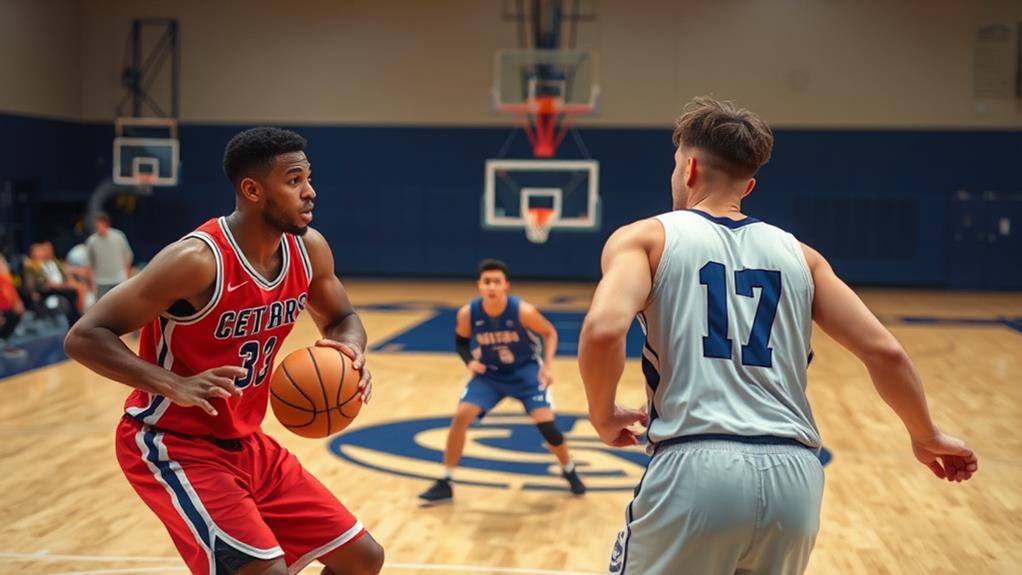
To successfully execute the pick and pop, you need to master key techniques for both the ball handler and the screener.
Understanding different positions and their roles can enhance your team's offensive strategies.
Focus on timing your movements and maintaining clear communication to adapt to defensive shifts.
Ball Handler Techniques
When you step up to run the pick and pop, focusing on your ball handler techniques can make all the difference. Start by maintaining a low and balanced stance to enhance your explosiveness and control. This stance allows you to attack off the screen effectively and change direction quickly when needed.
Utilize fakes and jab steps to manipulate the defender, creating separation to maximize the screen set by your teammate. It's essential to wait for the screener to establish contact with the defender before using the screen. This approach helps you avoid offensive fouls while maximizing space for your drive or shot.
As you attack, keep your head up to read the defense, identifying open teammates and reacting accordingly. Quick decision-making is key here; aim to make your move within two dribbles after using the screen. This urgency enables you, as a ball handler, to capitalize on scoring opportunities created by the pick and pop action.
Screener Movement Strategies
Effective screener movement is vital for maximizing the success of the pick and pop play. First, establish a solid position and communicate your intentions clearly to the ball handler. This guarantees both of you're synchronized and ready for execution.
Use subtle movements and fakes to create separation from the defender, making it tougher for them to predict your actions. The angle of your screen is important. Position yourself so the defender has to navigate around you, ideally making contact with the inner half of your body.
Once you've set the screen, quickly assess the situation. Decide whether to roll to the basket or pop out for a shot based on the defender's reaction and the ball handler's movement. Timing is key here. Wait for the ball handler to utilize the screen fully before making your move.
If you choose to roll to the basket, be ready to receive the pass. Conversely, if you pop out, confirm you're in a good shooting position. By mastering these screener movement strategies, you'll greatly enhance the effectiveness of the pick and pop play.
Timing and Communication
Mastering the pick and pop relies heavily on timing and communication between the ball handler and the screener. Effective timing is essential; as the ball handler, you should wait until the screener has established solid contact with the defender before making your move. This maximizes separation and scoring opportunities. To synchronize your efforts, clear signals or verbal cues enhance communication, ensuring both players know what to expect.
When setting the screen, the screener must position themselves effectively, usually perpendicular to your path. This angle creates the best chance for a clean rollout toward the basket or the perimeter.
Once the screen is set, quickly read the defense. You should make decisions within two dribbles to capitalize on the space or any mismatches created.
Both you and the screener need to maintain awareness of each other's positions. This awareness allows for quick adjustments based on the defense's reaction, which dramatically enhances the effectiveness of the pick and pop play.
Techniques for Ball Handlers
To successfully execute the pick and pop, you need to focus on several key techniques as a ball handler. First, maintain a low and balanced stance to maximize your explosive movement. The shot clock necessitates swift decision-making, so waiting for the screener to set an effective screen is essential; this not only helps you avoid offensive fouls but also creates separation from your defender.
Strategic shot selection is significant here, so don't rush the process.
Once the screen is set, utilize fakes like jab steps or directional dribbles to manipulate the defenders and enhance your scoring opportunities. Attack aggressively off the screen, ideally within two dribbles, to capitalize on the defensive confusion. This quick movement can catch your defender off guard.
While maneuvering around the screen, keep your head up. This allows you to read the defense and spot open teammates for potential passes or shots. By staying aware of your surroundings, you can make smarter decisions on the court.
Strategies for Screeners
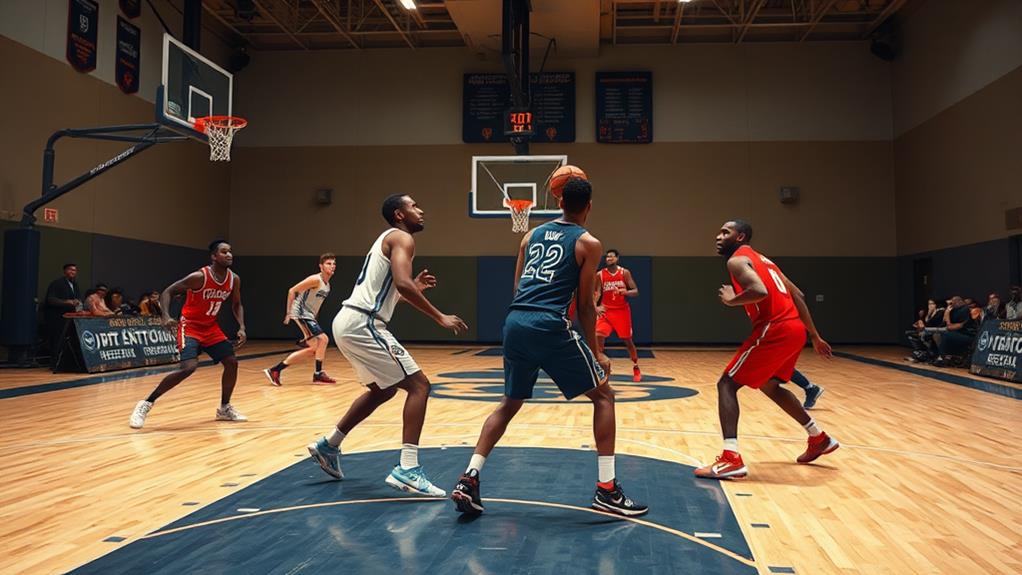
Setting a solid screen is the foundation of a successful pick and pop. To do this, you should make contact with the inner half of your body against the screener's defender. This contact slows them down, creating space for your ball handler to maneuver.
As gameplay has evolved, the importance of effective screens—along with strategies like the pick-and-roll—has become vital in modern basketball, emphasizing teamwork and coordination just as seen with evolution of offensive strategies. Once you've set the screen, quickly assess the defender's reaction to decide whether to roll towards the basket or pop out for a jump shot.
Communication with your ball handler is essential. By anticipating each other's movements, you can make swift decisions that capitalize on the defensive setup. Timing is also important; wait for your ball handler to take advantage of the screen before making your move. Premature actions might disrupt the play and give the defense an opportunity to recover.
As you roll towards the basket, keep your hands up to present a target for the ball handler. This guarantees they know where you're and can deliver the pass effectively.
Defensive Responses to Pick and Pop
When facing a pick and pop, you'll notice that defenders often adjust their strategies to counteract your moves.
With the evolution of defensive strategies, teams may switch on screens or employ a hard hedge to disrupt the ball handler's flow, reflecting the emphasis on transitioning defensive tactics.
Understanding these common defensive responses will help you exploit gaps and create scoring opportunities for your team.
Defensive Adjustments Against PnP
In facing a pick and pop situation, defenders must quickly adapt their strategies to counteract the offensive team's movements effectively. One option is to switch defenders. While this can help match up against the screener, be wary of mismatches, especially if the screener is a skilled shooter.
You might also consider a hard hedge, where the screened defender steps out to impede the ball handler, allowing the screener to roll or pop into open space afterward.
Another solid approach is drop coverage, which keeps the defender below the screen, compelling the ball handler to take an open shot if unguarded. Always gauge the screener's shooting ability; if they're not a threat beyond the arc, going under the screen might be a viable tactic. However, this can lead to open shots if they're proficient at shooting from distance.
Effective communication among defenders is essential. Make sure everyone is aware of the offensive player's movements and coordinates their defensive strategies.
This collective awareness can considerably enhance your defense against pick and pop situations, allowing you to adjust on the fly and minimize scoring opportunities.
Common Defensive Strategies
To effectively defend against the pick and pop, you'll want to contemplate several common strategies that can disrupt the offensive flow.
One effective approach is the hard hedge strategy, where the defender forces the ball handler away from the basket. This puts pressure on them to either split the defense or find an open teammate.
If you decide to implement switching on the pick and pop, make sure your team communicates well to avoid mismatches.
Another option is drop coverage, where the defender below the screen quickly closes out on the ball handler, creating immediate shooting opportunities if they're left open. If the ball handler isn't a significant shooting threat, going under the screen can help your defense reposition to protect the basket more effectively.
Lastly, consider using show defense, which involves stepping into the lane to disrupt the ball handler's penetration. This allows you to gauge whether to allow a shot or force a drive based on the defender's positioning.
Variations of Pick and Roll
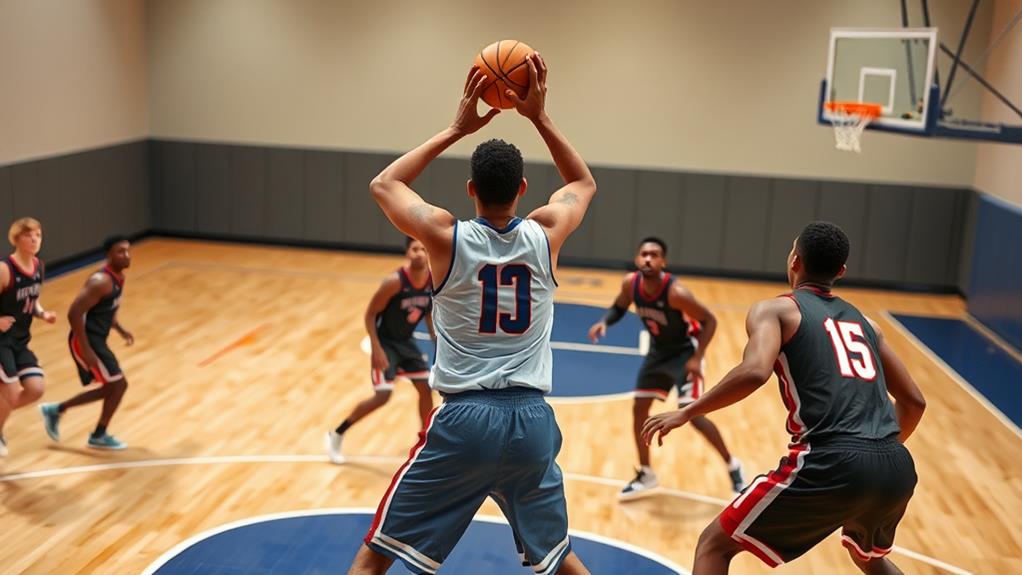
The pick and roll isn't just a single play; it features several variations that can keep defenses guessing. One popular variation is the pick and pop, where the screener moves to an open spot for a jump shot instead of rolling toward the basket. This creates a prime opportunity for an open shot, especially if the defense collapses on the ball handler.
Utilizing data-driven strategies can further enhance the effectiveness of these plays by informing players on the best shooting spots based on defensive tendencies.
Another effective variation is the pick and slip. In this scenario, the screener fakes the screen and quickly slips behind the defender to receive a pass. This exploits the defender's momentary confusion and opens up scoring chances.
Both of these variations heavily rely on your ability to quickly recognize defensive alignments and your screener's shooting accuracy. The effectiveness of these plays heightens when executed with precision, adding complexity to your offensive strategies.
It makes it harder for the defense to predict your next move. Notable duos, like Nash and Stoudemire, have showcased these variations in professional play, demonstrating their effectiveness.
Historical Examples of Success
Mastering the pick and pop has led to some of the most successful duos in basketball history, showcasing its impact on the game. One of the most iconic examples is John Stockton and Karl Malone during their time with the Utah Jazz in the 1990s. Their chemistry on the court allowed them to execute the pick and pop with precision, leading to numerous victories and playoff appearances.
Additionally, the importance of continuous learning in refining this skill can't be overstated, as players analyze their performances and adapt strategies.
Another great example of this strategy can be seen with Steve Nash and Amar'e Stoudemire, who effectively utilized high-screen plays to propel the Phoenix Suns to multiple playoff runs. Their fast-paced offense demonstrated how the pick and pop can create open shots and scoring opportunities.
In modern basketball, the Golden State Warriors, with Stephen Curry and Draymond Green, have revolutionized the pick and pop, emphasizing spacing and shooting efficiency. Their innovative approach has set new standards in offensive strategies.
Even in Euroleague basketball, the combination of Dimitris Diamantidis and Sofoklis Schortsanitis has shown the effectiveness of the pick and pop, leading to successful seasons.
These historical examples illustrate just how vital the pick and pop is in achieving success on the court.
Importance in Other Sports
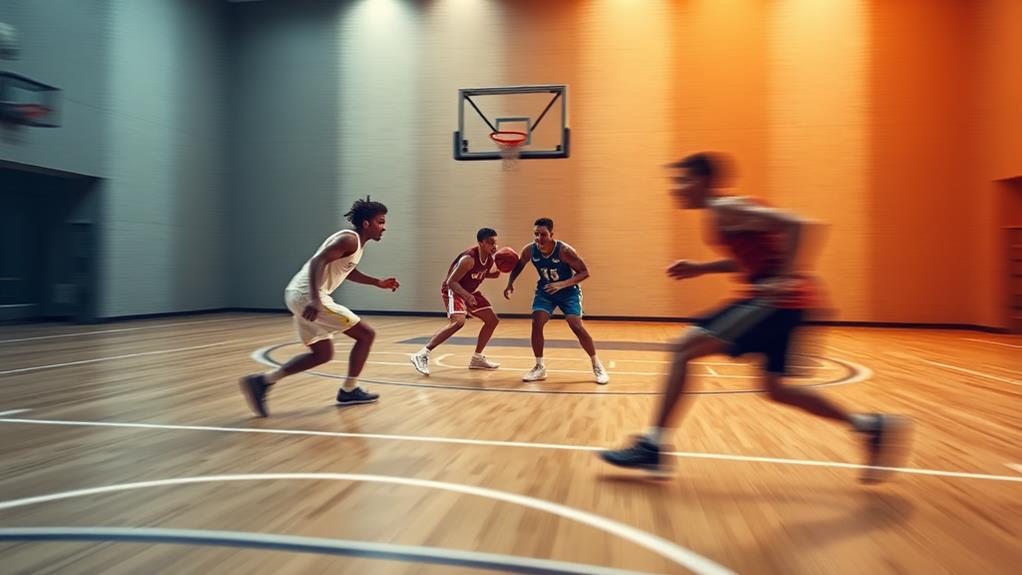
In various sports, the principles behind the pick and pop extend far beyond basketball, showcasing its adaptability and effectiveness. Take box lacrosse, for instance, where players utilize the pick and roll to create scoring opportunities. By setting a screen, one player can confuse defenders, allowing teammates to move into open spaces for quick shots. This strategy mirrors what you see in basketball but highlights how versatile these tactics can be.
In American football, similar offensive strategies rely on blocking schemes to create openings for ball carriers. Here, teamwork is essential; players must communicate effectively to execute these plays successfully. The pick and roll's success in these sports emphasizes the importance of strategic planning among teammates.
Whether in lacrosse, football, or basketball, the core concepts of setting a screen and working together form the backbone of effective offensive plays. By adopting these principles across different sports, you can enhance your understanding of teamwork and tactical execution, ultimately leading to greater success on the field or court.
The adaptability of the pick and roll proves that solid strategies can transcend individual sports, making them valuable assets in any athletic context.
Coaching Tips and Drills
Coaches looking to enhance their team's execution of the pick and pop should focus on drills that prioritize timing and communication between the ball handler and screener.
Start with small-sided games that simulate pick and pop scenarios. This allows players to recognize defensive reactions and decide quickly whether to roll or pop.
Emphasize screen angles by teaching your screener to maintain a low stance and effective footwork to set solid screens. The screener should be ready to either take an open shot or receive a pass from the ball handler after the screen.
Incorporating corner pick and roll situations can also add complexity to the drill, helping players adapt to different game scenarios.
Consider implementing video analysis during practice sessions. Reviewing successful pick and pop plays helps players visualize correct positioning and decision-making in real-game situations.
Conclusion
In the dynamic world of basketball, mastering the pick and pop can elevate your game to new heights. It's like a dance between the ball handler and screener, creating openings for scoring opportunities. By understanding the roles and executing the steps with precision, you'll find success on the court. So, embrace the strategy, practice diligently, and watch your team thrive as you unearth the potential of this powerful play. Your journey to basketball greatness starts here!

